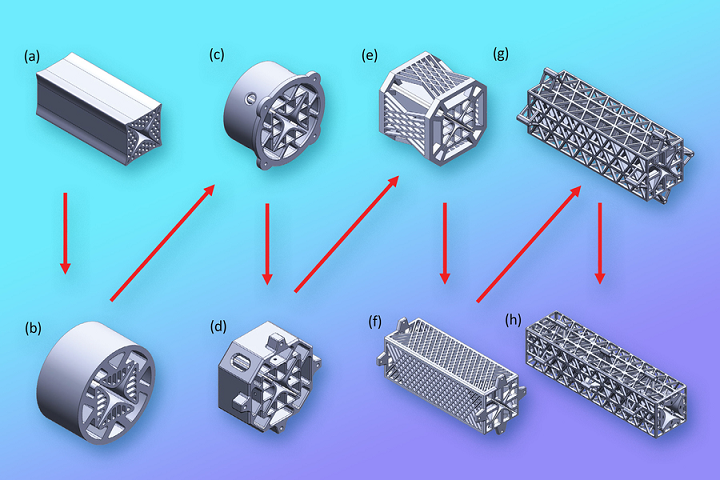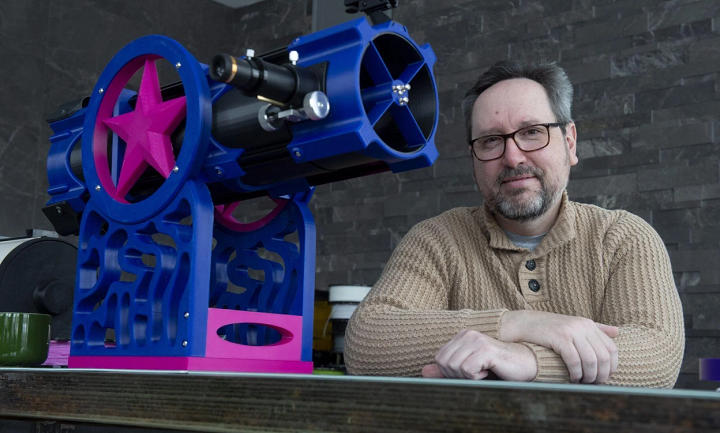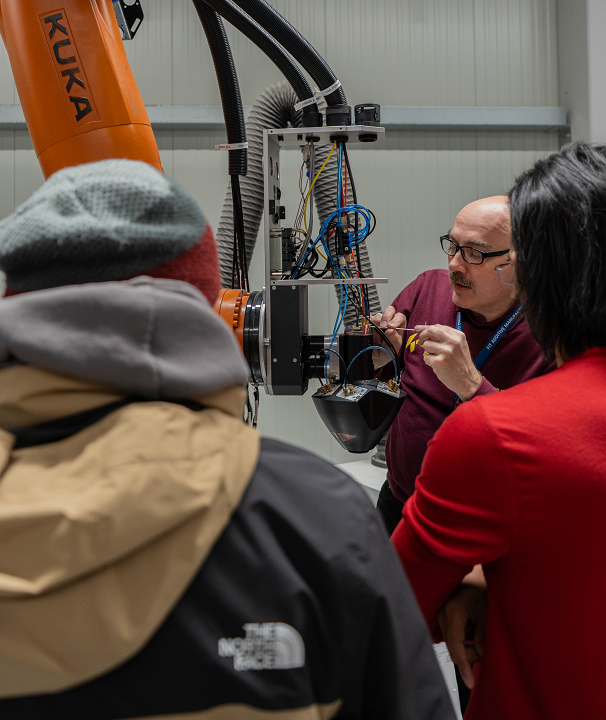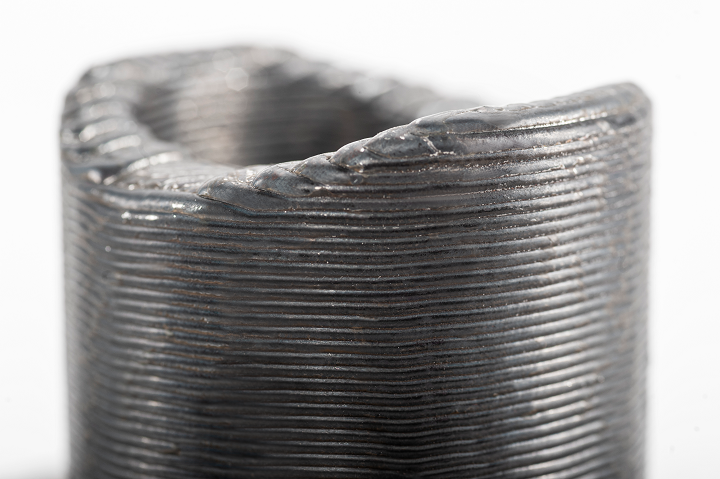“My biggest hope is that other communities will find a way to come together like we have. That would be the best,” Michel said.
In today’s 3D Printing News Briefs, we’re starting out with post-processing, as SKZ Würzburg is using a shot blast system from AM Solutions for its research. Moving on to business, FIT AG has been appointed as a Meltio Service Bureau, and speaking of Meltio, its technology used by Snowbird Technologies was a finalist at the recent MilAM awards. Finally, MIT researchers 3D printed the core component of a mass spectrometer, and a Canadian man is sharing his design for a 3D printed low-cost telescope.
SKZ Invests in Post-Processing System from AM Solutions

SKZ uses the S1 to study the effects of different blasting media on surface quality. The brain gear on the left is blasted with glass beads, clearly showing inclusions and uneven surfaces. In the picture on the right side, the brain gear is blasted with poly beads, resulting in a significantly more homogenous surface.
The German Plastics Center (SKZ), one of the largest research institutes for plastic materials in its field, is focused on training and research in the 3D printing field, and much of their work centers around materials and post-processing. To help with its research, the team recently purchased an S1 shot blast system from AM Solutions – 3D post processing technology, a brand name under Rösler Oberflächentechnik GmbH and located nearby. SKZ has a center of competence for AM in Würzburg, which develops training programs and handles multiple research projects, and one of the things SKZ analyzes there is the effect of blast media on the surface finish of 3D printed parts, as well as the consistency and efficiency of shot blasting results. The S1 has an easy blast media exchange, which enables quick, direct comparisons between various media, including ceramic, glass, or poly beads. The research SKZ performs with the AM Solutions S1 is very helpful in creating efficient process chains
“In our research with new materials for powder bed based additive manufacturing the post processing stage is an extremely important subject,” said Kevin Popp, senior scientist for additive manufacturing at SKZ. “For example, right now we study the effect of different blast media on the surface finish of different plastic materials. For this purpose, SKZ is utilizing the S1 system. We are particularly impressed by how adaptable this system is for our post processing activities, for example, how simple it is to exchange the blast media.
“For volume production the repeatability of the results and time are essential parameters, which we study carefully. With our manual shot blasting operations the surface finishes were all over the board. The S1 produces consistent surface finishes on large work piece volumes, even on extremely complex components like brain gears with their delicate gear tooth geometries. In the past it took us a whole day to blast 300 pieces. And the results were highly inconsistent. Today we just need 15 minutes for the same work piece volume, with excellent, consistent surface finishes.”
Meltio Appoints FIT AG as Service Bureau in Germany & DACH Region
Wire laser metal deposition (LMD) technology manufacturer Meltio announced that industrial AM integrator FIT AG is its first official service bureau in Germany and the DACH region. FIT AG works to provide affordable, accessible metal 3D printing services to several industries, and chose to incorporate Meltio’s wire LMD technology to its portfolio, which will allow it to significantly contribute to application development in Germany and other DACH countries Austria and Switzerland. LMD uses clean, inexpensive commodity welding wire, and precisely stacks weld beads on top of one another once in a laser-generated meltpool. Knowhow Wilhelms evaluated a test system for FIT AG with positive results, so by adopting the Meltio Engine—integrated into a robotic arm—FIT AG will also help improve and advance Meltio’s LMD technology, and support the regional demand for Meltio’s parts in several industrial applications.
“We are thrilled to be working with FIT AG and KnowHow Wilhelms, as this collaboration between us serves as a great indicator of how Meltio’s partner ecosystem is evolving,” said Moisés Moza Sanchez, Meltio’s Sales manager for the DACH region. “Together we will be able to cater to the ever-growing interest in Meltio’s technology and its applications. As well as by leveraging FIT’s knowledge, we will be able to further develop the adoption of Meltio unique wire-laser metal additive manufacturing for different industries.”
Snowbird Technologies & Meltio Finalists in MilAM’s 2024 Awards
At the recent Military Additive Manufacturing Summit and Technology Showcase (MilAM), Snowbird Technologies was chosen as a MilAM Awards finalist for Expeditionary and Tactical 3D Printing Excellence. The company partners with Meltio to offer unique wire-laser metal AM solutions for creating and repairing metal parts for the U.S. Army, and the two were selected as finalists for the development of the patented Snowbird Additive Mobile Manufacturing Technology (SAMM Tech) platform. This is a hybrid manufacturing platform that uses both CNC finishing and Meltio’s unique wire-laser metal 3D printing, and as it’s been integrated into an intermodal shipping container, the platform is deployable, so production can be brought to the point of need.
The annual MilAM Awards recognize groups and individuals that exemplify outstanding achievement in 3D printing in support of the mission priorities of the U.S. Department of Defense, looking at how AM technologies can solve supply chain issues and enhance capabilities to improve warfighter flexibility and readiness. Specifically, the Expeditionary and Tactical Excellence Award is given to a government or industry representative for their significant contributions and work in delivering advanced manufacturing solutions to the tactical edge. Although this MilAM award ultimately went to Craitor, and not Snowbird and Meltio, their efforts to supply the warfighter with enhanced AM capabilities to improve readiness and reduce lead time for critical parts are obviously getting noticed.
MIT Researchers 3D Print Filter For Portable Mass Spectrometer

Because additive manufacturing allows the researchers to easily try new designs, they created a number of different quadrupole filters before arriving at the final iteration (h), which is surrounded by a series of triangular lattices to provide durability. Image: Courtesy of the researchers, edited by MIT News.
Mass spectrometers are used to identify chemical substances for applications like geological surveying, crime scene analysis, and toxicology testing. But they’re expensive, bulky, and easy to damage, which limits how effectively they can be used in the field. An important step towards making these devices portable is reducing both the weight and the cost, and a team of MIT researchers used 3D printing to create the main component of a mass spectrometer—a cheaper, lighter, miniature mass filter, known as a quadrupole, which measures the chemical components in a sample to identify a substance by sorting charged particles based on their mass-to-charge ratio. The team used vat photopolymerization and heat-resistant glass-ceramic resin to print the filter in one step, for only a few dollars, and in just a few hours, and it’s just as precise as a commercial-grade one. Their quadrupole features hyperbolic rods, surrounded by an intricate network of triangular lattices for durability and coated with a thin metal film to make them electrically conductive.
“We are not the first ones to try to do this. But we are the first ones who succeeded at doing this. There are other miniaturized quadrupole filters, but they are not comparable with professional-grade mass filters. There are a lot of possibilities for this hardware if the size and cost could be smaller without adversely affecting the performance,” said Luis Fernando Velásquez-García, principal research scientist in MIT’s Microsystems Technology Laboratories (MTL) and senior author of the team’s paper detailing the miniaturized quadrupole. He’s spent 20 years working to produce a 3D printed, portable mass spectrometer.
“In the end, we made quadrupoles that were the most compact but also the most precise that could be made, given the constraints of our 3D printer.”
Canadian Man’s 3D Printed Low-Cost Telescope on Github

Brian Michel with a Skyward 150 3D printed telescope in his Guelph home. His plans to build the telescope are available free. Image: Mathew McCarthy, Waterloo Region Record.
Finally, 51-year-old Brian Michel of Guelph, Ontario has loved astronomy since he saw Jupiter’s moons through a department store telescope four decades ago. So he founded Ten Telescopes, which supports fellow star gazers by organizing events and sharing Mchel’s designs for a low-cost, 3D printed telescope called the Skyward 150 through the Blue Door Astronomy Library, located in his home. Also at his home is a roofless shed—the Bent Nail Observatory—which is a space for the community of Ten Telescopes volunteers to come and assemble 3D printed telescopes. Michel’s telescope has a red dot pointer for accurate aim, a counterbalance at the bottom end for attaching smartphones to the eyepieces, and is 3D printed out of tough ABS provided by Tundra 3D, his son’s company. Everything you need to make your own Skyward 150 telescope, including design files, an assembly guide, and a user manual, can be downloaded from GitHub for free, and the necessary parts to build it only cost between $300-350.
Subscribe to Our Email Newsletter
Stay up-to-date on all the latest news from the 3D printing industry and receive information and offers from third party vendors.
You May Also Like
Further Understanding of 3D Printing Design at ADDITIV Design World
ADDITIV is back once again! This time, the virtual platform for additive manufacturing will be holding the first-ever edition of ADDITIV Design World on May 23rd from 9:00 AM –...
3D Printer Maker EVO-tech Reborn as NEVO3D — Once More With Feeling
EVO-tech was a 3D printing service and original equipment manufacturer established in 2013 and based in Schörfling am Attersee, Austria. The company produced high-quality material extrusion systems featuring linear bearings,...
3D Systems Brings 3D Printed PEEK Cranial Implant to the U.S. with FDA Clearance
For more than 10 years, 3D Systems (NYSE:DDD) has worked hand-in-hand with surgeons to plan over 150,000 patient-specific cases, and develop more than two million instruments and implants from its...
CDFAM Returns to Berlin for Second Annual Symposium
The second CDFAM Computational Design Symposium is scheduled for May 7-8, 2024, in Berlin, and will convene leading experts in computational design across all scales. Building upon the first event...

































